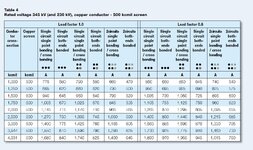aslamajec123
Electrical
- Aug 24, 2009
- 10
we have been calculating ampacity of subsea 400kV 3 core 2500 sq.mm and 2000 sq.mm Cu cables using CYMCAP software . But we noticed that there is only marginal increase (Les than 10A) in the current carrying capacity of 2500 sq.mm cable over 2000sq.mm. Where as there has been significant increase in ampacity when we checked for single core cables of same cross section and also with 3 core cables with smaller cross sections . Can you tell me what would be the main reasons for no significant increase in the ampacity of 3 core 2500 sq.mm cable over 2000 sq.mm ? Is this well expected ?

